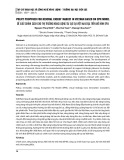
ISSN: 2615-9740
JOURNAL OF TECHNICAL EDUCATION SCIENCE
Ho Chi Minh City University of Technology and Education
Website: https://jte.edu.vn
Email: jte@hcmute.edu.vn
JTE, Volume 19, Issue 06, 2024
10
Designing Solar-Powered Electric Vehicle Charging Stations for the
Development of Future Green Cities
Hoang Minh Vu Nguyen1* , Nguyen Ngoc Nhu To1, Thuy Anh Tran2, Hoang Trung Nguyen3
1University of Architecture Ho Chi Minh City, Vietnam
2Ben Tre Import Export Joint Stock Company (Energy Control Specialist), Vietnam
3VNU High School for the gifted Ho Chi Minh City, Vietnam
*Corresponding author. Email: vu.nguyenhoangminh@uah.edu.vn
ARTICLE INFO
ABSTRACT
Received:
21/07/2024
This paper presents an overview of the ideas, general design, and
preliminary cost estimation for electric vehicle charging stations in planned
areas. The selection of a charging station model that integrates solar panels
connected to the national grid, having energy storage unit is discussed. This
model is suitable for certain urban areas with potential for solar energy
usage in electricity generation, contributing to efficient energy use,
emission reduction, and decreased electricity consumption from the
national grid, aiming towards zero-emission cities and environmental
protection. The calculation process is based on the technical specifications
of the Vinfast electric vehicle, with a battery capacity of 42kWh. The
preliminary estimates of the research indicate that the initial investment
cost is very high. However, the potential for capital recovery from the
system is quite rapid and feasible upon implementation. The research
calculations show that an integrated solar energy electric vehicle charging
station system is feasible for the Ba Tơ town area in Quang Ngai province.
The research results provide a planning orientation for technical
infrastructure systems in sustainable and modern urban development in the
coming years.
Revised:
18/08/2024
Accepted:
21/08/2024
Published:
28/12/2024
KEYWORDS
Electric vehicle;
Electric vehicle charging station;
Solar energy;
Charging station planning;
Urban infrastructure planning.
Doi: https://doi.org/10.54644/jte.2024.1621
Copyright © JTE. This is an open access article distributed under the terms and conditions of the Creative Commons Attribution-NonCommercial 4.0
International License which permits unrestricted use, distribution, and reproduction in any medium for non-commercial purpose, provided the original work is
properly cited.
1. Introduction
The rapid development of electric vehicles (EVs) is a good solution to energy and environmental
issues [1], [2], [3]. Consequently, the demand for electric vehicle charging stations in urban areas is
increasing. According to Quang Ngai online news, as of 2021, the province has over 1.24 million people,
with more than half owning gasoline-powered vehicles. This contributes to the increase in greenhouse
gas emissions. Building a network of EV charging stations within urban technical infrastructure is a
crucial step, aligning with the development trend towards smart or green cities in the future. Some
previous studies on this topic include [4], which presents a planning model considering the road network
structure, vehicle flow information, distribution system structure, and constraints on charging station
distribution. The study indicates that the road network and traffic flow directly impact the location of
charging stations. The models and methods presented in the paper primarily aim to coordinate the
influence of these factors to find the optimal planning scheme. In [5], a model is proposed that considers
charging requirements, the economy, and the grid safety of electric vehicles to address the issue of
charging station planning using a genetic algorithm in MATLAB. In [6], the design, simulation, and
economic analysis of a grid-connected solar energy system for an EV charging station at Thu Dau Mot
University are presented. The study estimates the efficiency of the PV system and its potential to reduce
CO2 emissions. Economic issues still exist, resulting in low investment efficiency due to long payback
periods. In [7], the technical and economic analysis under different solar irradiation conditions in
Vietnam for optimizing PV-powered EV charging stations is presented. The optimal configuration and
investment efficiency of PV-powered EV charging stations in each urban area are significantly
influenced by the solar irradiation value and the feed-in tariff (FIT) of rooftop solar energy. In [8],
Chandra Mouli and the research team compared various EV charging configurations to reduce grid

ISSN: 2615-9740
JOURNAL OF TECHNICAL EDUCATION SCIENCE
Ho Chi Minh City University of Technology and Education
Website: https://jte.edu.vn
Email: jte@hcmute.edu.vn
JTE, Volume 19, Issue 06, 2024
11
dependency and maximize the use of solar energy. However, due to seasonal variations in sunlight, the
local storage system still cannot completely eliminate grid dependency, with the average daily PV
energy production differing fivefold between summer and winter. Jensanyayut [9] presented an analysis
of installing solar-powered charging stations within the power distribution system. The content of the
paper serves as a practical resource for evaluating and determining suitable values in the design of solar-
powered charging stations for electric vehicles within the power distribution system. Muharmamad
Akmal and his colleagues [10] presented the design and installation of a solar-powered charging station
system for EVs in the UAE environment. The determination of the optimal location for EV charging
stations has attracted significant attention from researchers. In [11], [12], authors suggest methods for
analyzing approaches, objectives, and constraints to identify the best location for charging stations and
assess the impact of charging load on the distribution network. In [13], Ngoc presented a method for
calculating the battery system for an electric vehicle, ensuring that the output power is identical to that
of the original internal combustion engine vehicle. The vehicle uses only Li-ion batteries, providing a
range of nearly 300 km per charge. Additionally, Huynh Quoc Viet in [14] applied fuzzy logic to control
traction force to optimize the power management of hybrid electric vehicles (HEVs) and analyzed its
effectiveness through several test cycles such as NEDC and UDDS. The HEV model was implemented
using Matlab/Simulink, with simulation results showing significant improvements in fuel consumption
efficiency. Phap Vu Minh et al. [15] presented a study analyzing the optimal configuration of solar-
powered EV charging stations in Vietnam, considering various solar radiation conditions.
This study focuses on designing electric vehicle charging stations integrated with solar power
systems, aiming not only to meet charging demand but also to contribute to efficient energy use and
environmental protection. The calculation and design process is based on the technical specifications of
Vinfast electric vehicles and the solar energy potential in the Ba Tơ town area of Quang Ngai province.
This study also emphasizes optimizing the locations of the charging stations, ensuring they are placed
in positions that best utilize solar energy and are convenient for electric vehicle users. It contributes to
the planning of technical infrastructure systems for sustainable urban development in the future.
2. Materials and Methods
The steps to carry out the research process for designing solar-powered electric vehicle charging
stations are conducted in stages, from general to detailed interms of planning, economic, and technical
issues and shown in Figure 1.
Figure 1. Flowchart for the research and calculation process of designing solar-powered electric vehicle
charging stations

ISSN: 2615-9740
JOURNAL OF TECHNICAL EDUCATION SCIENCE
Ho Chi Minh City University of Technology and Education
Website: https://jte.edu.vn
Email: jte@hcmute.edu.vn
JTE, Volume 19, Issue 06, 2024
12
2.1. Electric vehicle and electric charging station analysis
2.1.1. Electric vehicle
Electric vehicle includes Battery electric vehicles (BEV), Plug-in Hybrid Electric Vehicles (PHEV),
Hybrid electric vehicles (HEV) and Extended Range Electric Vehicles (EREV).
2.1.2. Modes for electric vehicle charging stations
An overview of the charging levels at electric vehicle charging stations is presented in Table 1. A
chart illustrating the distance traveled by the vehicle per hour of charging at charging levels is depicted
in Figure 2. The charging levels consider factors such as charging voltage, current type, active power,
maximum output power, charging time, and charging connector type.
Table 1. Overview of charging levels in electric vehicle charging stations
Level 1
Level 2
Level 3
Charging voltage
120 V
208/220 V
200 – 450 V
Current type
AC
AC
DC
Active power
1.4 kW
7.2 kW
50 kW
Maximum output power
1.9 kW
19.2 kW
150kW
Charging time
12h
3h
20’
Charging connector
J1772
J1772
J1772 Combo, CHAdeMO and
super fast charging
Figure 2. The graph of electric vehicle travel distance increases with each hour of charging
2.2. Selection criteria for electric vehicle charging stations
Public charging stations are particularly suitable for installation at public toll plazas such as railway
station, parking lots, airports, shopping centers, restaurants, hotels, and resorts.
Figure 3 shows the connection diagram of the grid-connected PV system with storage battery. The
system includes: solar panels, DC disconnect, charge management unit, storage battery, inverter for DC-
AC conversion, electrical cabinet for power distribution to electric vehicle charging stations, main
electrical cabinet connected to the electronic meter before connecting to the grid. Electric vehicle
charging stations will take electricity from the solar panel system and storage battery through the inverter
controller and power distribution unit. In case the solar panel system is not enough to supply, the
charging station will take electricity from the local power grid.

ISSN: 2615-9740
JOURNAL OF TECHNICAL EDUCATION SCIENCE
Ho Chi Minh City University of Technology and Education
Website: https://jte.edu.vn
Email: jte@hcmute.edu.vn
JTE, Volume 19, Issue 06, 2024
13
2.3. Grid-connected solar PV model with backup grid
Figure 3. Grid-connected solar PV model with backup grid
2.4. Analysis of current status and natural conditions of the project
The design location of the electric vehicle charging station is at the parking lot of the commercial
and service project, on the sidewalk of a park belonging to an entity in downtown Ba To town, Ba To
district, Quang Ngai province. This area has great potential for solar energy development, with an
average annual radiation intensity of 3.489 kWh/m²/day. Total annual sunshine hours in Quang Ngai
range from approximately 2000 to 2600 hours, with monthly averages of 150 to 200 hours. Based on
data from GLOBAL SOLAR ATLAS extracted by coordinates of Quang Ngai province (Latitude:
14.963535°; Longitude: 108.664263°), the following data are obtained: Global horizontal irradiation
(GHI): 1652.4 (kWh/m2/day), Direct normal irradiation (DNI): 1172.9 (kWh/m2/day), Global tilted
irradiation for optimized surface (GTI): 1658.3 kWh/m²/day, Maximum tilt angle for daily productivity
optimization: 8/180°, Potential photovoltaic energy output (PVOUT): 1335.6 kWh/kWp/day.
The location of the electric car charging station is located in the design area integrated into the
parking lot of the commercial - service project and the access route to the residential park. It is situated
north of prominent landmarks such as Ba To district hospital, Ba To uprising monument, and Ba To
museum. This location not only serves the 788 residents living in the area but also welcom over 10,000
neighboring residents and visitors. This paper proposed to use 4-seater electric cars to facilitate
transportation for residents, nearby residents, and visitors. The required number of cars is 4 (green park)
and 7 (commercial center). Technical specifications of the vehicle (Vinfast E34) is shown in [16].
2.5. Design of electric vehicle charging station
2.5.1. Calculation parameters
Based on the technical specifications of the vehicles, the power consumption is equal to the battery
capacity of 42 kWh per vehicle. There will be 1 station per vehicle, with each station charging 6 times
per day.
Power consumption per day by the load
𝐴𝑛𝑔−𝐺𝑅𝐸𝐸𝑁 𝑃𝐴𝑅𝐾 =42×4× 6 = 1008 𝑘𝑊ℎ
(1)
𝐴𝑛𝑔−𝐶𝑂𝑀𝑀𝐸𝑅𝐶𝐼𝐴𝐿 =42× 7×6 = 1764 𝑘𝑊ℎ
(2)
Total DC charging capacity needed to supply stations with charging frequency at each station
𝑃∑charging = (1008+1764)×0.8 = 2217.6 𝑘𝑊
(3)
The output of solar electricity generated
E = 2278×1134
1000 ×22.26
100 ×5.48×0.9 = 2836.06 𝑘𝑊ℎ
(4)
Calculation on the number of sunny hours in a day

ISSN: 2615-9740
JOURNAL OF TECHNICAL EDUCATION SCIENCE
Ho Chi Minh City University of Technology and Education
Website: https://jte.edu.vn
Email: jte@hcmute.edu.vn
JTE, Volume 19, Issue 06, 2024
14
The average actual sunlight hours per day in Quang Ngai range from 6 to 8 hours/day.
Occasionally, sunlight hours can reach up to 10 hours/day with low frequency and different
radiation intensity. For long-term calculations and stable conditions, we choose 8 hours/day as
the standard sunlight hours.
The number of kWh of electricity generated by a 1kWp solar panel system is calculated as
follows:
1 kWp × 8 h/day = 8 𝑘𝑊ℎ/𝑑𝑎𝑦
(5)
This means that there are 8 sunlight hours per day, a 1 kWp generates approximately 8 kWh of
electricity per day in average. Therefore, over the course of one month, the solar battery system
would produce 180 kWh of electricity.
Therefore, the DC power that the system needs to generate
𝑃𝑃𝑉.𝐷𝐶 =2836.06
8= 354.51 𝑘𝑊
(6)
From (1) and (2), we establish the following ratio:
∆𝑃 = 𝑃𝑃𝑉.𝐷𝐶
𝑃∑𝑠ạ𝑐 =354.51
2217.6 = 0.16 =16%
(7)
Therefore, solar energy provides 16% (equivalent to 354.816 kW) of the electric vehicle charging
demand, necessitating an additional 84% (equivalent to 1862.784 kW) from the grid to ensure the
charging process for the charging stations. Hence, we have the load demand for charging stations at the
green park and commercial service facilities as follows:
𝐴𝑛𝑔−𝐺𝑅𝐸𝐸𝑁 𝑃𝐴𝑅𝐾
′=1008× 0.16 =161.28 𝑘𝑊ℎ
(8)
𝐴𝑛𝑔−𝐶𝑂𝑀𝑀𝐸𝑅𝐶𝐼𝐴𝐿
′=1764×0.16 =282.24 𝑘𝑊ℎ
(9)
From geographical location data, we have the parameters presented in Tables 2 and Table 3.
Table 2. Total solar irradiance in the atmosphere horizontally by month (H, kWh/m2/day).
Province, City
Month
I
II
III
IV
V
VI
VII
VIII
IX
X
XI
XII
Quang Ngai
3.95
4.82
6.03
6.54
6.83
6.56
6.71
6.53
5.88
4.97
3.76
3.17
Table 3. Conversion factor table for total irradiance R between a surface tilted 10° facing west relative to the
horizontal surface.
Province, City
Month
I
II
III
IV
V
VI
VII
VIII
IX
X
XI
XII
Quang Ngai
1.04
1.03
1.02
0.99
0.97
0.96
0.96
0.98
1.00
1.02
1.03
1.03
2.5.2. PV capacity
PV capacity in January is as shown below:
𝑃𝑃𝑉 =𝑊
𝑅 ×𝐻 ×𝑉 =161.28
3.95× 1.04×0.76 =51.66 𝑘𝑊𝑝
(10)
Similarly, calculations for the remaining months, the results are presented in Table 4.












![Trắc nghiệm Mạch điện: Tổng hợp câu hỏi và bài tập [năm hiện tại]](https://cdn.tailieu.vn/images/document/thumbnail/2025/20251118/trungkiendt9/135x160/61371763448593.jpg)













